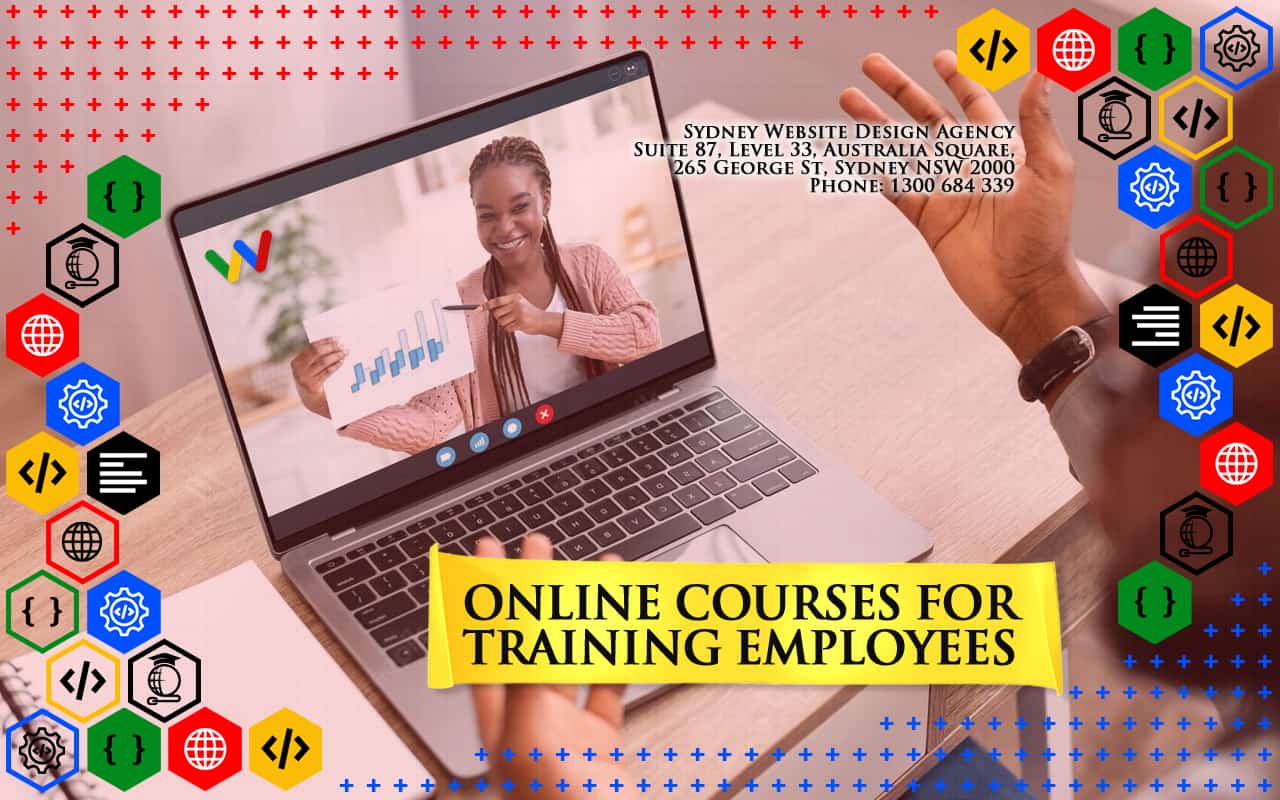Building Your Online Course Website
Because it is flexible and trustworthy, owners of small businesses are increasingly turning to online study or education. They realise they can learn whatever skills they need without sacrificing their time running the venture.
From launching a design course to photo editing, they find ways on how to onboard new employees and train the new ones in how to more efficiently handle their day-to-day activities that help run a business. And there are other advantages as well: for example, you can take courses on your schedule and still have plenty of attention left over for making your business thrive.
This guide will show you how to find, design, and implement an online course that can help your business in many ways. We’ll start by exploring the different types of courses available and their unique benefits. Then we’ll dive into the process of designing an impactful online course step-by-step. Finally, we’ll leave you with some tips on making sure your students get the most out of the experience.
The Benefits of Online Learning for Businesses
As a business owner, you are constantly investigating how to improve efficiency and productivity. Employees who receive ongoing training can better handle their workloads and make fewer mistakes. They are also more likely to be engaged with their work and motivated to stay with your company for the long haul. Even without previous experience, exposing employees with comprehensive online training programs helps strengthen their problem-solving skills as well as their expertise and work knowledge.
Investing in employee development has always been a smart business move, but traditional methods like in-person seminars and conferences can be pricey and time-consuming. Online courses offer a more convenient and cost-effective solution that can still deliver high-quality results for companies and businesses.
Here are some of the specific benefits you’ll enjoy when you design an online course for your business:
Versatile
You can design the content to your brand or company’s needs: When you create your own course, you have the freedom to focus on the topics that are most relevant to your business. You can also adjust the difficulty level to ensure that employees receive the right level of challenge.
Flexible and Convenient
One of the biggest advantages of online learning is that employees can study at their pace and on their schedule. This is especially beneficial for busy professionals who might not be able to take time off work to attend a seminar. An employee can gain knowledge and techniques ideal for their niche industry without having to travel or leave the office.
Can Reach Global Audiences
With an online course, you’re not limited by geography. You can easily share your content with employees or customers located anywhere in the world. Whether you are training employees located in a different city or offshore employees, you can easily provide them access to your courses without having to fly them to your location. It is a practical solution that can build their technical skills even at home.
It’s cost-effective: Online courses are usually much cheaper to produce than traditional educational materials like textbooks. They also tend to be more affordable for students, which makes them a great option for businesses working with a tight budget.
Online courses have come a long way in providing remote education and training for both the educational sector and businesses. As it continues to develop and grow, we can expect more of these websites to be a huge part of the success of businesses.
Introduction
More learners are attending online courses to advance their knowledge in that field and to achieve better results. According to WE FROM just in 2021 alone, 195 million people attended online courses. From graphic design courses to interior design or even as complicated as Adobe Illustrator and game design, there is an online course waiting for you to unravel. Creative and technical skills can be learned and enriched online.
If you’re reading this, then you’re probably considering creating your own online course. And that’s great! Building and launching an online course can be a very profitable endeavor. But before you can start building your course, there are a few things you need to know. Your current creative and technical skills may now be up for the challenge. In this article, we’re going to walk you through the process of designing and launching your very own online course website – from online graphic design to UI design up to how to deliver the online study effectively to your audience.
So, what do you need to get started? You must have robust knowledge and ideas on how to create and design an online course website before attempting to create one. But what if you do not have the skills, creativity, or the prior knowledge to do so? Here is where Sydney Website Design Agency can help. We have created a comprehensive article on how to create and design an online course for your business. Oh, let’s not forget that online courses can also be used for internal trainings. Read on to learn more.
Table of Contents
- What is an Online Course Website
- What is the Purpose of an Online Course Websites
- Online Courses for Training Employees
- Design Online Course for Internal Training: The Basic Steps
- Tips to Remember When Creating an Online Design Course
- Creating Online Courses for Your Audiences
- Best eLearning Plugins for Your Website
- Promoting Your eLearning Website
- Using SEO in Marketing Your Online Course Website
- FAQs Design Online Course
- Best Tips in Creating Successful Online Course Website
What is an Online Course Website

An online course website is an online learning platform that offers courses taught by instructors from around the world. Students can enrol in these courses and access them at their convenience.
Most online course websites provide a variety of features, such as:
- A catalogue of courses offered
- The ability to search for courses by keyword, topic, or instructor
- Detailed descriptions of each course
- Free course guide
- Course objectives and outcomes
- Instructor biographies
- Course ratings and reviews
- Discussion forums
- Live chat features
- Technical support
An online course website typically serves students who want to learn new skills or topics from instructors all over the world. The value that this type of website offers is convenience and flexibility. Students can access these courses at their convenience and learn at their own pace.
The value of an online course website for businesses is convenience and flexibility. Businesses can offer their employees access to these courses at their convenience, and employees can learn new skills or topics at their own pace. Additionally, businesses can use online course websites to train new employees and promote employee development.
Online Courses for Training Employees

Employers are increasingly turning to online employee training courses as a way to provide employees with an interactive, hands-on training experience. These courses can be more economical in both time and money than conventional training, and offer employees a level of flexibility that is not possible with traditional training methods. Employees can access these courses at their convenience, and complete them at a comfortable pace in a helpful and easy to use user interface.
When choosing online employee training courses, employers should consider the following factors:
Course Content
The course content must be relevant to the needs of the employees. It should cover all the essential topics that employees need to know to perform their job duties effectively. The course content should also be engaging and interactive, so that employees will stay motivated throughout the duration of the course.
Instructor Qualifications
The instructor of the course should be knowledgeable and experienced in the subject. He or she should also be able to effectively communicate the course material to employees.
Technical Support
The provider of the online employee training courses should offer technical support in case there are any problems with the course content or delivery.
Course Length
The length of the course should be reasonable, so that employees can complete it within a reasonable timeframe.
Course Cost
The cost of the course should be affordable for the employer.
Employers should also consider the following factors when selecting online employee training courses:
Accreditation
The provider of the online employee training courses should be accredited by a reputable organisation. This will ensure that the courses are of high quality and meet the standards set by the accrediting body.
Course Delivery Method
The course delivery method should be convenient for employees. It should allow them to access the course material at their convenience and complete it at their pace.
Course Evaluation
The provider of the online employee training courses should offer a way for employers to evaluate the success of the course. This will help employers determine whether the course is meeting their needs.
Once employers have considered these factors, they can then select the online employee training courses that best meet their needs. By providing employees with quality training, employers can improve employee productivity and retention, and save money on training costs.
How to Design an Online Course for Internal Training: The Basic Steps

It’s widely known that static online courses are no longer cutting it. With technologies like augmented and virtual reality, interactive presentations, and more, today’s learners expect far more than text documents and videos.
Thankfully, most tools and course creators come with features that support interactivity. And happily, starting an interactive online training program has become much more doable. This article provides an overview of what you need to do to design and implement an interactive online course for internal training.
1. Figure out your business goals
Before anything else, you first need to determine the purpose or objectives of the course. That might mean anything from boosting employee performance to reducing company liability. Once you’ve identified the primary goal, ask yourself how the course will help achieve it.
2. Apply needs analysis
Once you know what you want to achieve with the course, it’s time to find out what your employees need to meet those objectives—this is called a needs analysis.
There are several methods you can use to collect this information:
- Use learning analytics to review data on employee performance
- Conduct interviews or focus groups with employees
- Give employees surveys
3. Choose your instructional design model
After you’ve determined the goals and needs of the course, it’s time to start thinking about the instructional design. This is the process of creating educational experiences that promote learning.
There are many models of instructional design, but three of the most popular are:
- The ADDIE model
- The SAM model
- The Rapid Prototyping model
4. Create your content
Now it’s time to start creating the actual content for your course. This can be in the form of text, audio, video, images, quizzes, games, and more. Think about what will engage your learners and help them meet the objectives of the course.
5. Implement and evaluate your course
Once you’ve created your content, it’s time to put it all together and launch the course. But that’s not the end of the story—you’ll also need to evaluate how well the course is achieving its objectives. You can do this by collecting data on learner performance, conducting surveys, or holding focus groups.
6. Make changes and improvements
Based on your evaluation, you may decide to make changes to improve the course. This could involve anything from tweaking the content to redesigning the entire instructional design. Whatever changes you make, be sure to evaluate their effectiveness, so you can continue to improve the course over time.
Following these steps will help you create an interactive online course that meets the needs of your employees and achieves your business goals.
Tips to Remember When Creating an Online Design Courses

Now that we’ve answered the question “why create an online course,” it’s time to get into the nitty-gritty of how to create an online course. This step-by-step guide will show you exactly what you need to do to develop a high-quality, valuable online course that your audience will love.
1) Choose Your Topic and Target Audience
The first step to creating an online course is choosing your topic and target audience. You must select a topic that you’re passionate about and that your target audience will find valuable. Keep in mind that your course doesn’t have to be perfect – you can always revise and update it as you go.
2) Outline Your Course Content
Once you’ve selected your topic, it’s time to start outlining your course content. Begin by brainstorming all the different topics that you want to cover in your course. Then, organise those topics into an outline or table of contents. This will help you stay on track as you develop your course content.
3) Develop Your Course Content
Now it’s time to start developing your actual course content. There are a few different ways that you can do this, such as creating video lectures, written presentations, or recording audio lessons. Whichever method you choose, make sure that your content is high-quality and engaging. Remember, you want your students to actually learn from your course, so don’t skimp on the quality of your content.
4) Promote Your Course
Once you’ve developed all of your course content, it’s time to start promoting your course. There are a few different ways that you can do this, such as through social media, email marketing, or paid advertising. Choose the promotion methods that will work best for you and your target audience.
5) Launch Your Course
After you’ve promoted your course and built up some interest, it’s time to launch your course. Make sure that everything is ready to go before you launch, such as setting up payment processing and creating a sales page. Then, sit back and watch as your students enrolled in your course and start learning from your amazing content!
Creating Online Courses for Your Audiences

Now that you know how to create an online course, here are a few tips that will help you design an even better course:
1) Keep It Focused
When selecting a topic for your course, it’s important to keep it focused. Don’t try to cover too many topics in one course, or else your students will get overwhelmed and confused. Instead, pick a specific topic and stick to it. This will help your students retain the information that they learn from your course.
2) Make It Engaging
Your course content should be engaging and interesting, or else your students will get bored and tune out. There are a few different ways that you can make your content more engaging, such as using video, audio, or interactive elements.
3) Promote It Effectively
If you want your course to be successful, then you need to promote it effectively. There are a few different ways that you can promote your course, such as through social media, email marketing, or paid advertising. Decide the promotion methods that will work best for you and your target audience. With effective research, you can find ways on how to promote your creation and disciplines to your employees and audiences.
4) Keep It Updated
Once you’ve launched your course, it’s important to keep it updated with fresh content. If there is one thing you need to learn about the web and search engines, they always seek to find fresh content to offer audiences. This will help keep your students engaged and interested in what you have to offer. Plus, it will show that you’re an expert in your field who is always learning and growing.
5) Offer Great Support
If you want your students to be happy with your course, then you need to offer great support. This includes offering help if they’re having trouble understanding the material, as well as providing feedback on their progress. By offering great support, you’ll ensure that your students are getting the most out of your course.
6) Use persuasive copywriting
The words you use on your website are critical! They should be persuasive and convincing, without being over the top. After all, you want to encourage visitors to sign up for your course. Whether you are offering design skills course, fashion design, logo design, UX design or any other types of online courses, you need to write them in a way that is engaging to your audiences.
7) Use an E-Commerce Solution
If you’re selling your courses online, you’ll need an e-commerce solution. Choose a platform that’s easy to use and set up, so you can start selling courses as soon as possible.
8) Promote Your Website
Once your website is live, it’s time to start promoting it! There are many ways to do this, but some of the most effective include social media marketing, content marketing, and search engine optimisation (SEO).
Creating an online course can be a great way to share your knowledge with the world and generate some extra income. Follow the steps outlined in this article, and you’ll be well on your way to designing an outstanding course. And don’t forget to use these tips to make sure that your course is even better!
Best eLearning Plugins for Your Website

Learn about the best eLearning plugins for your website that can help you easily create and manage online courses.
Creating an online course can be a daunting task, but with the right tools, it can be much easier. In this article, we’ll show you some of the best eLearning plugins for WordPress that can help you easily create and manage online courses.
With these plugins, you’ll be able to create beautiful courses with quizzes, assignments, and more. You’ll also be able to track student progress and protect your courses with password protection.
So, if you’re looking for a way to easily create and manage online courses, then check out these plugins.
1. LearnDash
LearnDash is one of the most popular WordPress LMS plugins. It comes with all the features you need to easily create and manage online courses. It includes support for quizzes, assignments, discussion forums, and more.
It also includes a student dashboard so students can easily track their progress. And it integrates with WooCommerce so you can sell your courses online.
2. LifterLMS
LifterLMS is a free WordPress Learning Management System plugin that makes it simple to develop, market, and maintain courses on your website. The base Lifter plugin includes a simple course builder as well as quizzes and dripped content, while paid add-ons expand Lifter’s capabilities with social learning, assignment creation, ecommerce tools, and more.
3. CoursePress
WordPress users who want to offer online courses can look no further than CoursePress. You may quickly sell or share online courses that come with video instruction, quizzes, automated assessments, file sharing capabilities, and completion certificates using CoursePress.
4. WP Courseware
WP Courseware makes it simple for businesses to create custom courses and manage learning processes from one central platform. You can design multiple courses, add multimedia content, and organise them any way you want using the drag-and-drop interface.
5. Sensei
Sensei is a WordPress learning management system that allows anybody to develop engaging eLearning courses and platforms using simple drag-and-drop features. With Sensei, anyone can create interesting lessons and quizzes in minutes.
Automattic, the team behind WordPress, WooCommerce, and Jetpack powered Sensei LMS to give you a reliable plugin with the ability to improve your site’s performance.
Promoting Your eLearning Website

You need to promote your eLearning website to gain popularity in your organisation, or even outside. It depends on where you intend to market its use.
1. Search Engine Optimisation (SEO)
Optimizing your website for the search engines is SEO. By ranking higher on SERPs, you improve your chance of being found by internet users. Multiple elements contribute to how well your site does in searches, such as tags and descriptions on individual pages, or backlinks and social media activity related to your website off-page.
2. Pay-Per-Click (PPC) Advertising
Pay-per-click advertising is a type of online advertising where you pay each time someone clicks on your ad. PPC ads can be effective for promoting your eLearning website because they allow you to target a specific audience and you only pay when someone actually clicks on your ad.
3. Social Media Marketing
Social media marketing is the process of using social media platforms like Facebook, Twitter, and LinkedIn to promote your eLearning website. You can use social media to share your eLearning courses, blog posts, and other resources with potential students. You can also use social media to build relationships with potential students and create a community around your eLearning courses.
4. Email Marketing
Email marketing is a great way to promote your eLearning website and courses because it allows you to reach a large audience with your message. You can use email to send out newsletters, announcements, and other information about your eLearning courses. You can also use email to build relationships with potential students and create a community around your eLearning courses.
5. Traditional Advertising
Traditional advertising methods like print advertisements, television commercials, and radio spots can be effective for promoting your eLearning website. These methods allow you to reach a wide audience with your message and can be very targeted.
Using SEO in Marketing Your Online Course Website

The importance of SEO in online marketing cannot be understated: 61 percent of marketers say that improving their organic reach is the top priority when it comes to inbound marketing, according to HubSpot research.
Organic traffic continues to be the most important source of website visits: although paid search and social media are great sources of leads and can generate quick results, they are not sustainable in the long term if you do not have a solid SEO strategy in place.
Design Online Course Frequently Asked Questions
What is an online course?
Which businesses should have an online course?
How do you build an inhouse training program?
How do you create a training curriculum?
These FAQs should give you a clearer understanding of how to leverage online courses to enhance your business and develop your team’s design skills. Whether you’re looking to create a comprehensive training curriculum or offer specialised design courses, the right approach can lead to significant career opportunities and career growth.
Your Best Tips in Creating Successful Online Courses Websites

So, what’s the takeaway? Just like anything else in business, creating a successful online course takes careful planning, execution, and follow-through. But with a little effort and the right tools, you can create a course that will help your business reach new heights.



















































